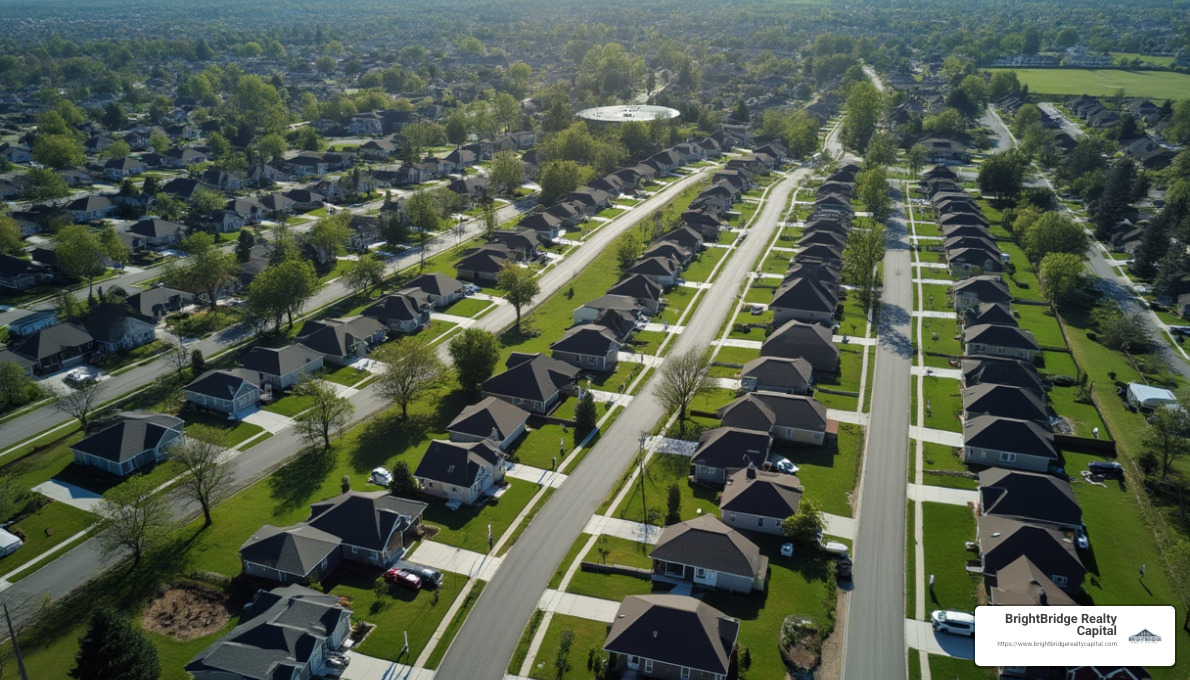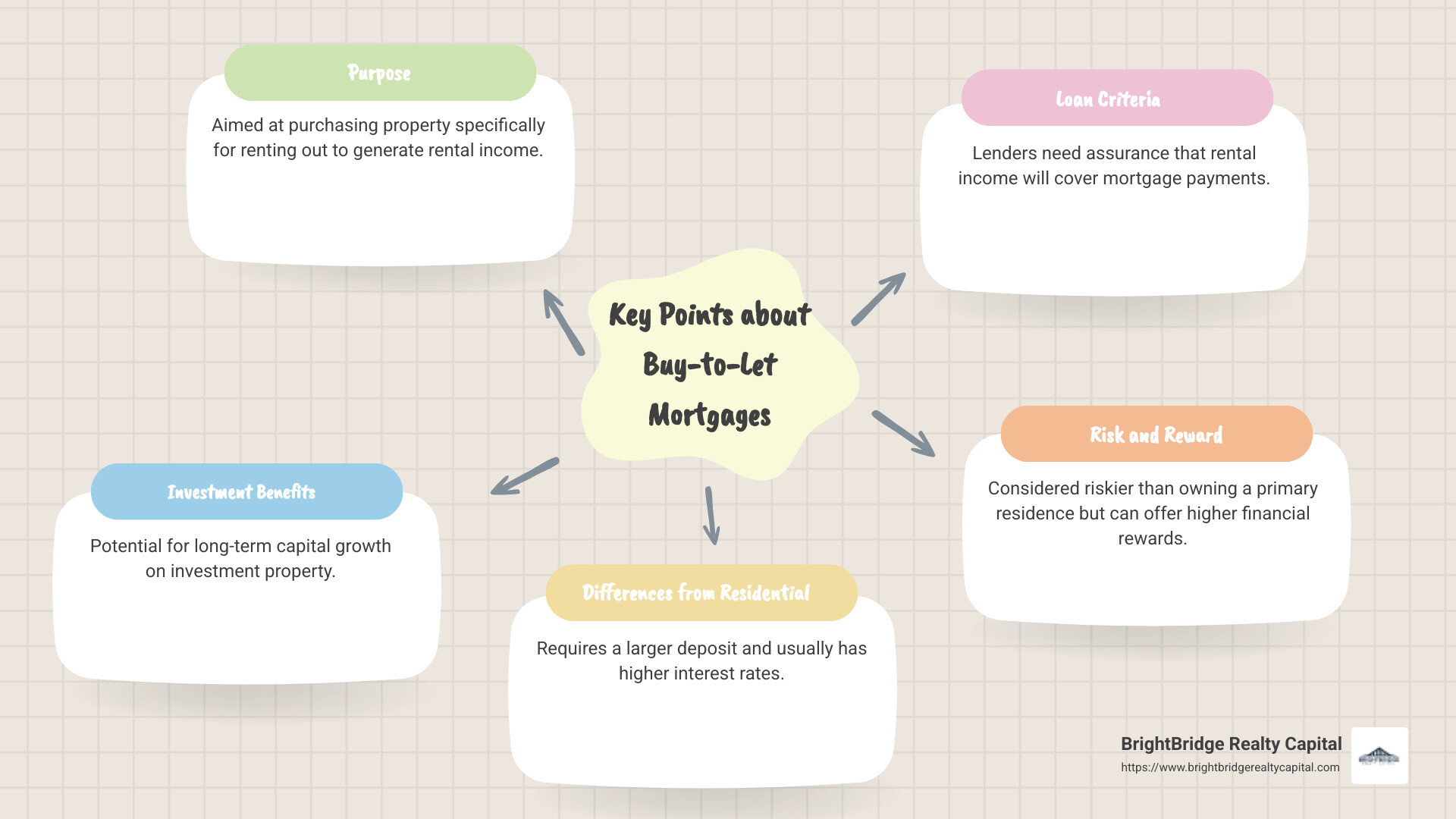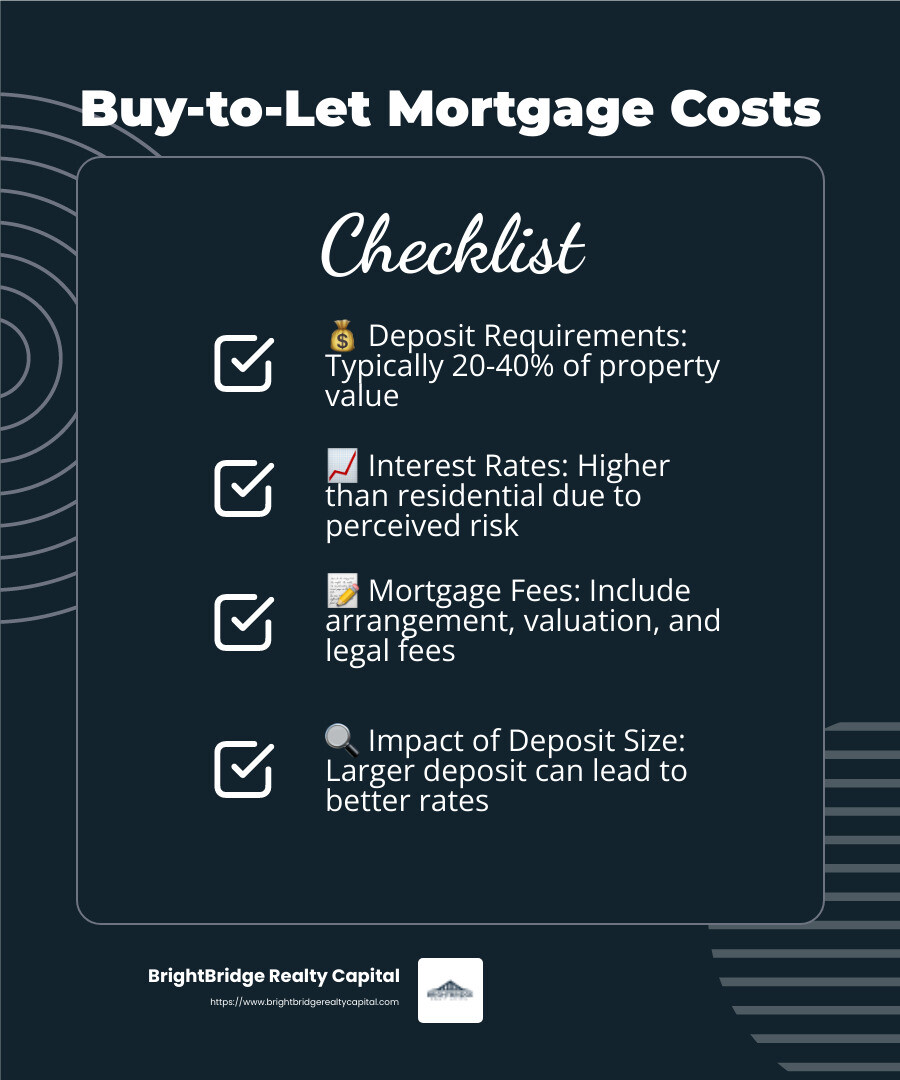Buy-to-Let Mortgages: The Key to Rental Property Success

Buy to let mortgage finance is a strategy many investors turn to when looking to generate rental income and build their property portfolios. But what exactly does it entail, and why might it be key to your rental property success?
Here’s a quick overview of what you need to know:
- Purpose: A buy-to-let mortgage is used to purchase property specifically for renting out, aiming for a steady rental income stream.
- Investment Benefits: Potential for long-term capital growth on your investment property.
- Differences from Residential Mortgages: Generally require a larger deposit and have higher interest rates.
- Loan Criteria: Lenders often want assurance that rental income will cover mortgage payments.
- Risk and Reward: Buying to let is considered riskier than owning a primary residence, often translating to higher financial rewards.
Buy-to-let mortgages have become an essential tool in the real estate investment landscape, especially for those planning to capitalize on rental property opportunities. Despite the appeal, it's a complex venture demanding careful financial planning and market understanding. From arranging financing to managing tenants, every step involves risk—but also prospects for rewarding returns.

Buy to let mortgage finance definitions:
Understanding Buy-to-Let Mortgages
Types of Buy-to-Let Mortgages
When diving into buy-to-let mortgages, understanding the various types available is crucial. Each type has its unique benefits and potential drawbacks, and your choice can significantly impact your investment strategy.
1. Interest-Only Mortgages
Interest-only mortgages are popular among buy-to-let investors. With this type of loan, you pay only the interest each month, not the principal. This means lower monthly payments, allowing you to maximize rental income. However, you'll need to repay the full loan amount at the end of the term. Many landlords plan to sell the property or refinance to cover this.
2. Capital Repayment Mortgages
Unlike interest-only loans, capital repayment mortgages require you to pay both interest and a portion of the principal each month. This results in higher monthly payments but ensures that by the end of the term, the entire loan is paid off. For those seeking long-term stability and peace of mind, this might be the way to go.
3. Fixed-Rate Mortgages
Fixed-rate mortgages offer stability by locking in an interest rate for a set period, usually between two to five years. This means your payments remain consistent, regardless of market fluctuations. It's a solid choice if you prefer predictability and want to avoid surprises in your budget.
4. Variable-Rate Mortgages
Variable-rate mortgages, on the other hand, have interest rates that can change over time. They often start with lower rates than fixed-rate options, but they can increase or decrease based on market conditions. This type of mortgage can be beneficial in a declining interest rate environment but risky if rates rise.

Choosing the right type of buy-to-let mortgage depends on your financial situation, investment goals, and risk tolerance. Whether you're interested in minimizing monthly payments with an interest-only mortgage or prefer the security of a fixed-rate option, understanding these types will help you make an informed decision.
Next, we'll explore the essential elements of buy to let mortgage finance, including deposit requirements and interest rates, to ensure you're well-prepared for your investment journey.
Buy-to-Let Mortgage Finance
When it comes to buy to let mortgage finance, understanding the eligibility criteria and costs involved is essential. Let's break down what you need to know before diving into rental property investment.
Eligibility Criteria
Getting approved for a buy-to-let mortgage involves meeting specific criteria. Here's what lenders typically look for:
Credit History: A good credit score is crucial. Lenders want to see a history of responsible borrowing. If your credit score is high, you're more likely to secure favorable terms.
Rental Income: Most lenders require the expected rental income to cover at least 125-145% of the mortgage payments. This ensures that the property can sustain itself financially.
Age Requirement: Generally, you must be at least 18 years old to apply. Some lenders also have an upper age limit, often around 70-75 years, by the end of the mortgage term.
Costs Involved
Understanding the costs associated with buy-to-let mortgages is key to planning your investment. Here's what to expect:
Deposit Requirements: Buy-to-let mortgages typically require a larger deposit than residential mortgages. Expect to put down at least 20-40% of the property's value. This higher deposit reduces the lender's risk.
Interest Rates: Interest rates for buy-to-let mortgages are usually higher than those for residential properties. This is due to the perceived risk of rental investments. Rates can vary based on the type of mortgage you choose, such as fixed or variable.
Mortgage Fees: Be prepared for various fees, including arrangement fees, valuation fees, and legal costs. These can add up, so factor them into your budget.
Deposit Size: The size of your deposit can influence the interest rate you're offered. A larger deposit often results in better rates, as it lowers the lender's risk.

Navigating buy to let mortgage finance requires careful consideration of both eligibility and costs. By understanding these elements, you're better equipped to make informed decisions and set the foundation for a successful rental property investment.
Next, we'll dig into how to secure the best buy-to-let mortgage deals, ensuring you get the most out of your investment.
How to Secure the Best Buy-to-Let Mortgage Deals
Securing the best buy-to-let mortgage deals can make a world of difference in your property investment journey. Here are some practical tips to help you steer this process, especially if you're a first-time landlord.
Compare Deals
Don't settle for the first mortgage offer you receive. Comparing deals from different lenders is crucial. Look at interest rates, terms, and fees. Some lenders might offer lower rates but charge higher fees, so calculate the total cost over the term of the mortgage.
Boost Your Credit Score
A strong credit score can open doors to better mortgage deals. Check your credit report for any errors and work on improving your score by paying bills on time and reducing outstanding debts. Lenders see a good credit score as a sign of reliability, which can lead to more favorable terms.
Understand Mortgage Types
Buy-to-let mortgages come in various forms, including fixed-rate, variable-rate, and interest-only. Each type has its pros and cons:
- Fixed-rate mortgages offer stability with consistent payments, protecting you from interest rate hikes.
- Variable-rate mortgages might start with lower rates, but they can fluctuate, impacting your monthly payments.
- Interest-only mortgages mean lower monthly payments, but you’ll need a plan to repay the principal at the end of the term.
Choose the type that aligns with your financial strategy and risk tolerance.
Property Selection
Choosing the right property is vital. Look for locations with low property taxes, good schools, and amenities like parks and shops. Areas with low crime rates and strong job markets attract more tenants. Location can significantly impact rental income and property value.
Legal Responsibilities
Being a landlord comes with legal duties. Familiarize yourself with landlord-tenant laws in your area, including security deposit rules, lease agreements, and eviction processes. Understanding these responsibilities helps you avoid legal issues and maintain a good relationship with your tenants.
Tax Liabilities
Rental income is taxable, so it's important to understand your tax obligations. You can deduct certain expenses, such as mortgage interest, property management fees, and repairs. Keep detailed records to make tax time easier and consult a tax professional if needed.
By following these tips, you'll be better equipped to secure the best buy-to-let mortgage deals and manage your property investment effectively.
Next, we'll address some frequently asked questions about buy-to-let mortgages to clear up any remaining uncertainties.
Frequently Asked Questions about Buy-to-Let Mortgages
Can I live in my buy-to-let property?
No, you can't live in your own buy-to-let property. These mortgages are specifically designed for landlords who rent out the property to tenants. If you plan to live in the property, you'll need a standard residential mortgage instead. This distinction is crucial to ensure you're using the right type of financing for your living situation.
How easy is it to get a buy-to-let mortgage?
Getting a buy-to-let mortgage is similar to getting a residential mortgage, but there are key differences in eligibility criteria. Generally, you'll need a larger deposit, often around 25% of the property's value. Interest rates for buy-to-let mortgages are usually higher than those for residential mortgages. Lenders will also look at your personal financial situation, including your credit history and existing debts, as well as the potential rental income from the property. That lenders prefer applicants who already own a residential property, but it's not a strict requirement.
What’s the criteria for a buy-to-let mortgage?
To qualify for a buy-to-let mortgage, you must meet several criteria:
- Age Requirement: You must be at least 18 years old. If you're applying jointly, all applicants must meet this age requirement.
- Credit History: A good credit score is important. Lenders will review your credit history to assess your reliability in repaying debts.
- Rental Income: The expected rental income from the property is crucial. It usually needs to cover at least 125% to 145% of the mortgage payments.
- Deposit Size: A larger deposit, typically around 25%, is required compared to a standard mortgage.
- Borrowing Limits: Lenders may impose limits based on your income and existing financial commitments.
Understanding these criteria can help you prepare and increase your chances of getting approved for a buy-to-let mortgage finance.
In the next section, we'll explore some practical tips for first-time landlords to help you steer the responsibilities of owning a rental property.
Conclusion
Investing in rental properties can be a powerful way to build long-term wealth. By carefully navigating buy-to-let mortgage finance, you can create a stable income stream and a growing property portfolio.
At BrightBridge Realty Capital, we specialize in providing custom real estate financing solutions to help you achieve your investment goals. Our quick and flexible funding options make it easier for you to seize opportunities in the real estate market. Whether you're a first-time landlord or an experienced investor, our team is here to support you every step of the way.
With the right mortgage package, you can maximize your rental income and gradually expand your property portfolio. This not only offers financial security but also positions you for future success in the real estate market. By choosing BrightBridge Realty Capital, you're partnering with a lender committed to making your property investment journey as smooth and profitable as possible.
Ready to take the next step? Explore our services and let us help you open up the potential of your property investments.


